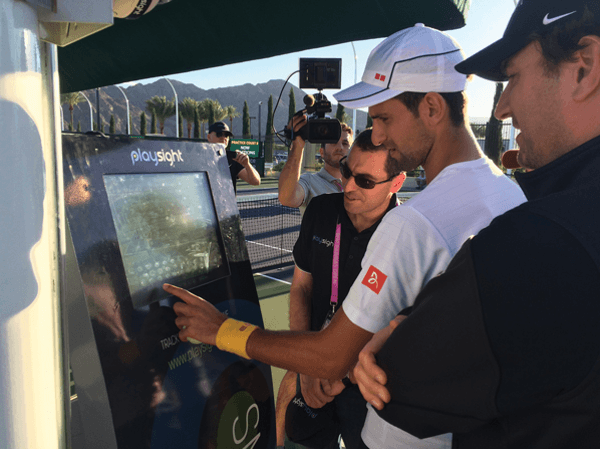PlaySight – Using Data Analytics to Improve Tennis Performance

PlaySight allows tennis players to improve their games by installing smart cameras that provide advanced analytics. It impressively appeals to both amateur players and professionals like Novak Djokovic. So how does it do it?
As a passionate (yet below-average) tennis player, I have been trying to improve my game for years. I have spent significant time taking tennis lessons that seem helpful, but it is hard to know if I am actually getting better. Now, there is an innovative data analytics company that is helping both amateur players like me and top professional players like Novak Djokovic improve their games.
PlaySight provides software-equipped cameras to create “SmartCourts”. Its customers install these HD cameras around its court, and then each time the players play, the cameras track advanced analytics on a their performance. For instance, a player can track the speed of their shots, the spin on their shots, whether each shot went in or out, percentage rates on each shot, and more. The system can then show them that data output, allowing the players and coaches can learn about their strengths and weaknesses in detail. Players can access the data both physically at kiosks beside the court (see photo below) or remotely from their technology devices.
The company creates value in two key ways:
- First, it allows players to learn far more than they ever could about their performance. This applies both while they are playing and afterwards. For instance, while they are playing, if they want to track the success of something as specific as their cross-court backhands, the system can beep if they miss their goal on certain shots. [1] This can allow their drills to be much more productive. Next, after they play, the analytics they learn can teach them about which shots they are most effective at and what their percentages were for certain types of shots, which can help improve their future game strategy and performance.
- Second, PlaySight allows players to gamify their drills. They can set custom goals on target areas for their shots, track their performance, and more. This gamification can further help players improve.
While PlaySight creates significant value, I believe it faces two primary challenges.
The first major challenge I see is competition. Companies like Keemotion and Minute.ly seem to offer comparable products that capture footage from multiple cameras to track data and provide analytics.[2] PlaySight will therefore have to choose their segment carefully. As of now, CEO Chen Shachar has stated that in contrast to its competitors, his focus is keeping the price low, so he can serve clients like high schools and universities.[3]
This strategy is concerning, but I do think it is the correct approach. The concern would be that if he keeps costs low while competitors build superior products, eventually his competitors will be able to lower costs and offer a more valuable proposition to his clients. However, PlaySight raised a $21M Series C round from Softbank Ventures and CE Ventures[4]. I therefore assume that keeping costs low does not involve sacrificing quality and innovation for them but rather involves taking a loss in order to sign more clients early on. I think this is likely the right approach, given that switching costs would be high for customers due to familiarity and the generally high price of these products.
The second challenge for PlaySight would be choosing whether to have a narrow focus on one sports or whether to diversify to many sports. Today, in addition to tennis, PlaySight can be used for basketball, volleyball, gymnastics, and martial arts.[5] Some of its basketball clients include the Golden State Warriors, Toronto Raptors, and Boston Celtics.[6] However, PlaySight’s value proposition is very different across sports and seems to be most advanced in tennis. In some sports, it seems to just offer filming and streaming capabilities. In pursuing this strategy, I think PlaySight faces a risk of spreading itself too thin by focusing on multiple sports. In doing so, it risks losing product quality in any sport. I would instead recommend that PlaySight pick one or two sports – likely tennis and basketball – to focus heavily on and build high-class expertise.
Altogether, I think that PlaySight’s data analytics offers immense value to tennis players in building strategy. I would recommend that it stay on course in building expertise, while narrowing its scope to one or two sports to ensure product quality remains high.
Bibliography:
[1] https://www.sportsbusinessdaily.com/Journal/Issues/2015/11/30/Research-and-Ratings/Company-Watch.aspx
[2] https://venturebeat.com/2020/02/14/playsight-ai-machine-learning-sports-analytics/
[3] https://venturebeat.com/2020/02/14/playsight-ai-machine-learning-sports-analytics/
[4] https://playsight.com/articles/softbank-ventures-and-ce-ventures-invest-in-playsight/
[5] https://www.sportsbusinessdaily.com/Journal/Issues/2015/11/30/Research-and-Ratings/Company-Watch.aspx
[6] https://venturebeat.com/2020/02/14/playsight-ai-machine-learning-sports-analytics/
Image credit:
- Photo of Novak Djokovic: https://www.sportsbusinessdaily.com/Journal/Issues/2015/11/30/Research-and-Ratings/Company-Watch.aspx
- Cover photo: https://venturebeat.com/2020/02/14/playsight-ai-machine-learning-sports-analytics/




Thank you for an great post! As another amateur tennis player, I’m so interested in the product especially to know what was different between my good and bad shots in terms of swing speed, spin, body balance, weight shift, etc., and I would assume many players like me would be interested as well. Assuming PlaySight charges customers on subscription model and given the high switching cost, I completely agree with your opinion that they should focus on customer acquisition with lower price point as long as they can continue product development which makes their technology a reliable practice partner.